University Accounting Assignment: IFRS, AASB and Financial Reporting
VerifiedAdded on 2022/10/12
|6
|1223
|451
Homework Assignment
AI Summary
This assignment solution addresses key concepts in company accounting, focusing on IFRS 13 and AASB 13 standards. It explores fair value measurement, depreciation methods, and impairment testing. The solution analyzes how these standards impact financial reporting, including the valuation of assets and liabilities. The assignment also examines the application of cash generating units and the importance of market participant assumptions. It offers a detailed analysis of the impact of historical cost versus fair value models and their implications for financial statements. The solution provides insights into the practical application of accounting principles within a business context, including considerations for asset valuation and financial statement presentation.
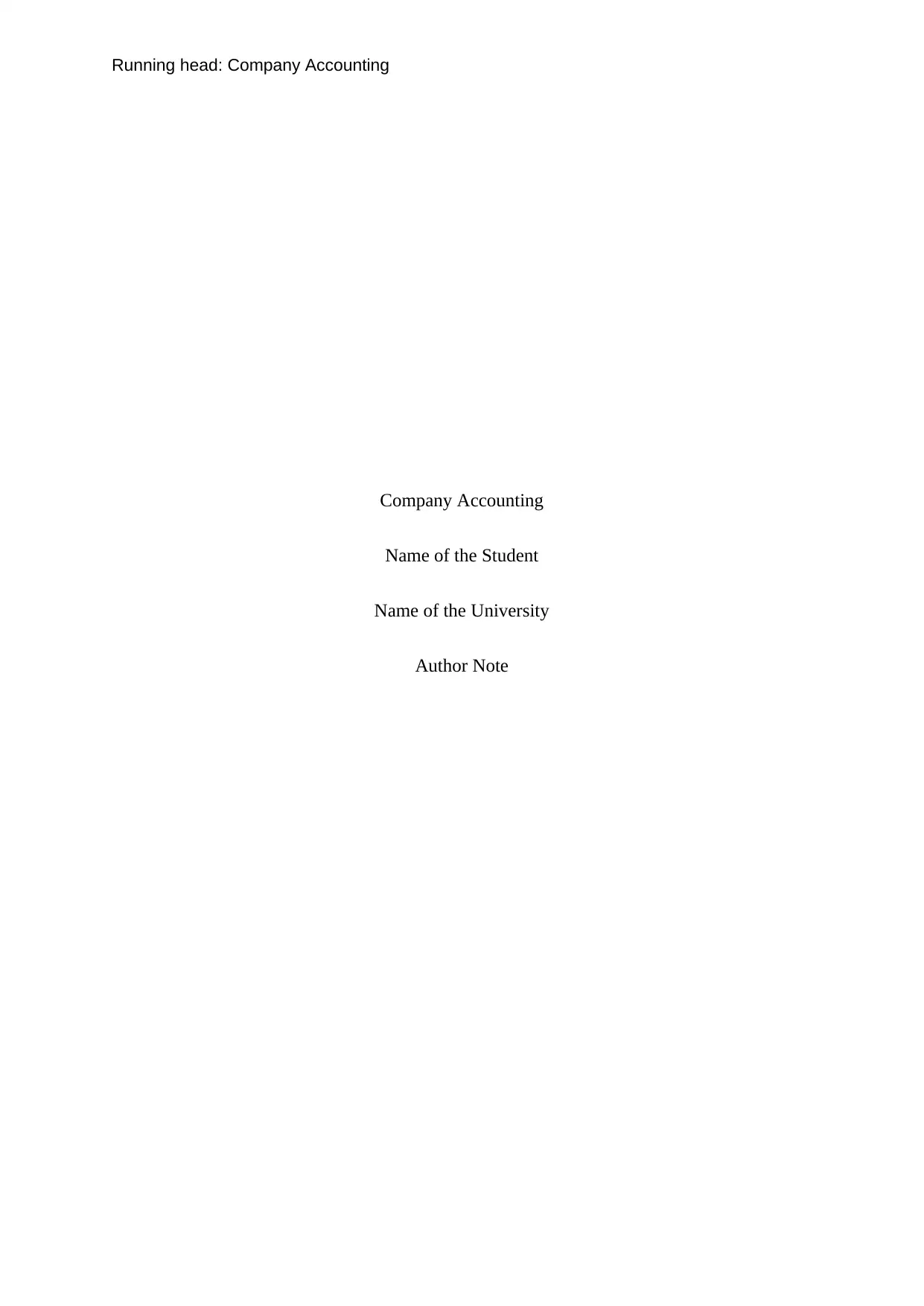
Running head: Company Accounting
Company Accounting
Name of the Student
Name of the University
Author Note
Company Accounting
Name of the Student
Name of the University
Author Note
Paraphrase This Document
Need a fresh take? Get an instant paraphrase of this document with our AI Paraphraser
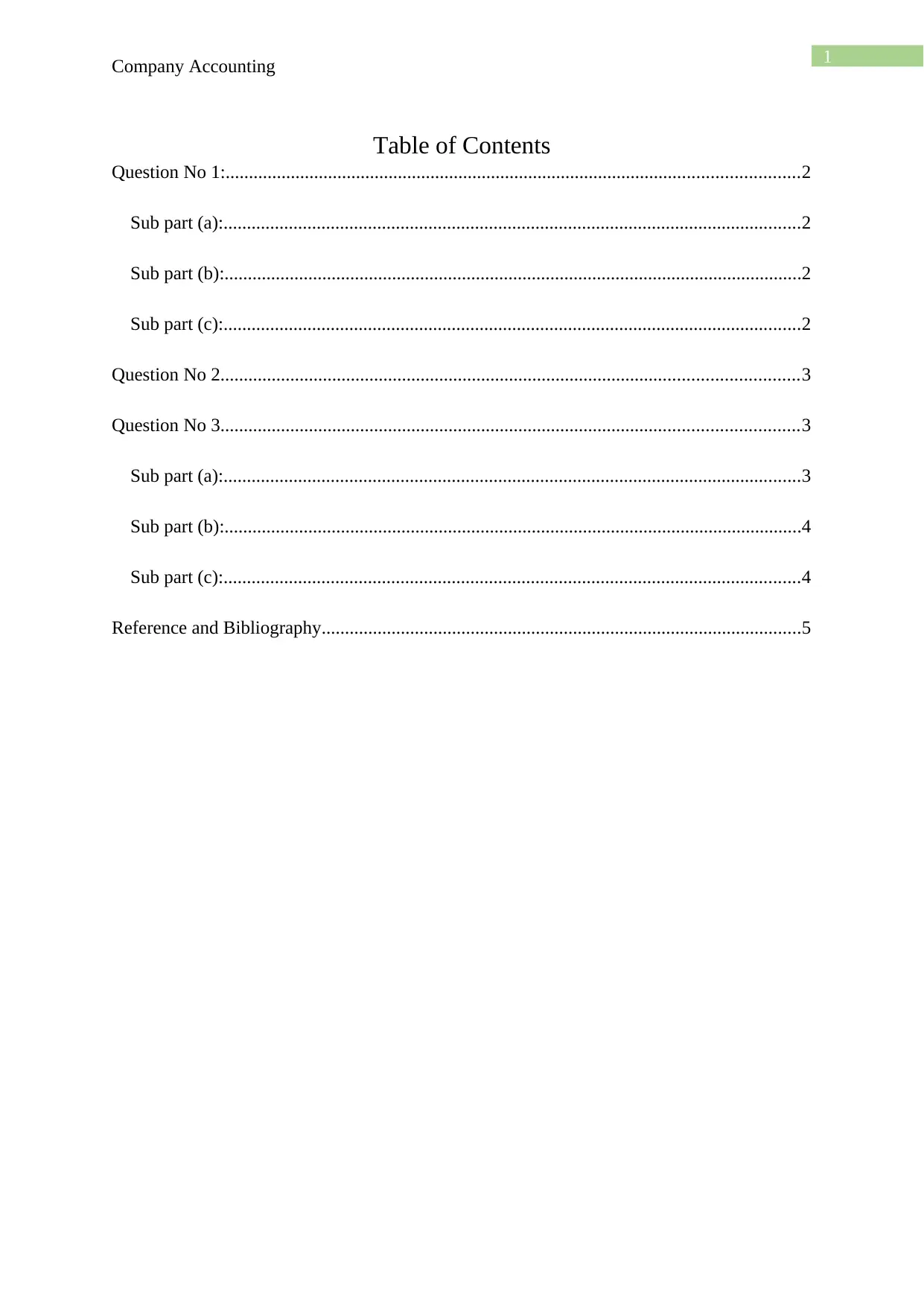
1
Company Accounting
Table of Contents
Question No 1:...........................................................................................................................2
Sub part (a):............................................................................................................................2
Sub part (b):............................................................................................................................2
Sub part (c):............................................................................................................................2
Question No 2............................................................................................................................3
Question No 3............................................................................................................................3
Sub part (a):............................................................................................................................3
Sub part (b):............................................................................................................................4
Sub part (c):............................................................................................................................4
Reference and Bibliography.......................................................................................................5
Company Accounting
Table of Contents
Question No 1:...........................................................................................................................2
Sub part (a):............................................................................................................................2
Sub part (b):............................................................................................................................2
Sub part (c):............................................................................................................................2
Question No 2............................................................................................................................3
Question No 3............................................................................................................................3
Sub part (a):............................................................................................................................3
Sub part (b):............................................................................................................................4
Sub part (c):............................................................................................................................4
Reference and Bibliography.......................................................................................................5
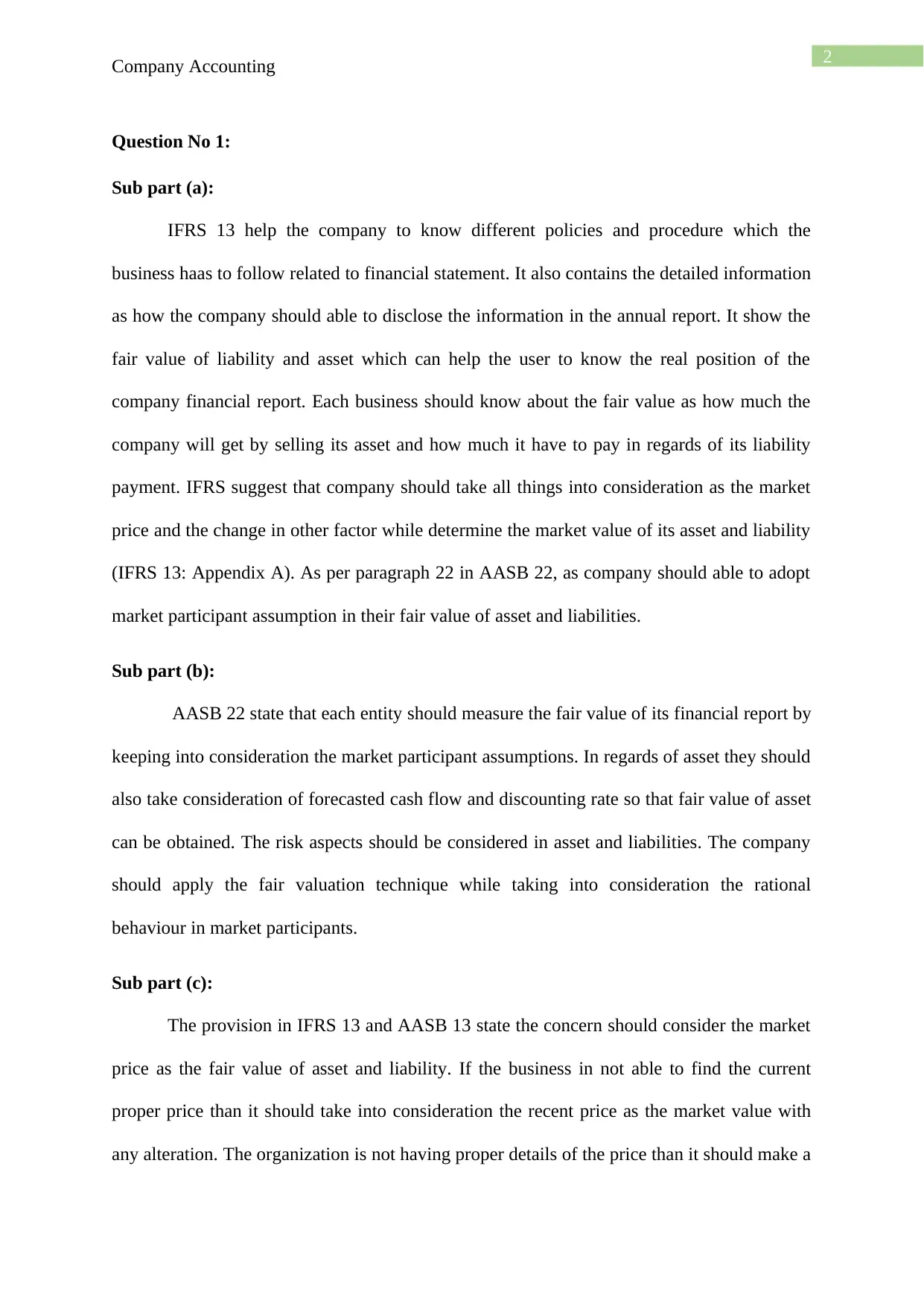
2
Company Accounting
Question No 1:
Sub part (a):
IFRS 13 help the company to know different policies and procedure which the
business haas to follow related to financial statement. It also contains the detailed information
as how the company should able to disclose the information in the annual report. It show the
fair value of liability and asset which can help the user to know the real position of the
company financial report. Each business should know about the fair value as how much the
company will get by selling its asset and how much it have to pay in regards of its liability
payment. IFRS suggest that company should take all things into consideration as the market
price and the change in other factor while determine the market value of its asset and liability
(IFRS 13: Appendix A). As per paragraph 22 in AASB 22, as company should able to adopt
market participant assumption in their fair value of asset and liabilities.
Sub part (b):
AASB 22 state that each entity should measure the fair value of its financial report by
keeping into consideration the market participant assumptions. In regards of asset they should
also take consideration of forecasted cash flow and discounting rate so that fair value of asset
can be obtained. The risk aspects should be considered in asset and liabilities. The company
should apply the fair valuation technique while taking into consideration the rational
behaviour in market participants.
Sub part (c):
The provision in IFRS 13 and AASB 13 state the concern should consider the market
price as the fair value of asset and liability. If the business in not able to find the current
proper price than it should take into consideration the recent price as the market value with
any alteration. The organization is not having proper details of the price than it should make a
Company Accounting
Question No 1:
Sub part (a):
IFRS 13 help the company to know different policies and procedure which the
business haas to follow related to financial statement. It also contains the detailed information
as how the company should able to disclose the information in the annual report. It show the
fair value of liability and asset which can help the user to know the real position of the
company financial report. Each business should know about the fair value as how much the
company will get by selling its asset and how much it have to pay in regards of its liability
payment. IFRS suggest that company should take all things into consideration as the market
price and the change in other factor while determine the market value of its asset and liability
(IFRS 13: Appendix A). As per paragraph 22 in AASB 22, as company should able to adopt
market participant assumption in their fair value of asset and liabilities.
Sub part (b):
AASB 22 state that each entity should measure the fair value of its financial report by
keeping into consideration the market participant assumptions. In regards of asset they should
also take consideration of forecasted cash flow and discounting rate so that fair value of asset
can be obtained. The risk aspects should be considered in asset and liabilities. The company
should apply the fair valuation technique while taking into consideration the rational
behaviour in market participants.
Sub part (c):
The provision in IFRS 13 and AASB 13 state the concern should consider the market
price as the fair value of asset and liability. If the business in not able to find the current
proper price than it should take into consideration the recent price as the market value with
any alteration. The organization is not having proper details of the price than it should make a
⊘ This is a preview!⊘
Do you want full access?
Subscribe today to unlock all pages.

Trusted by 1+ million students worldwide
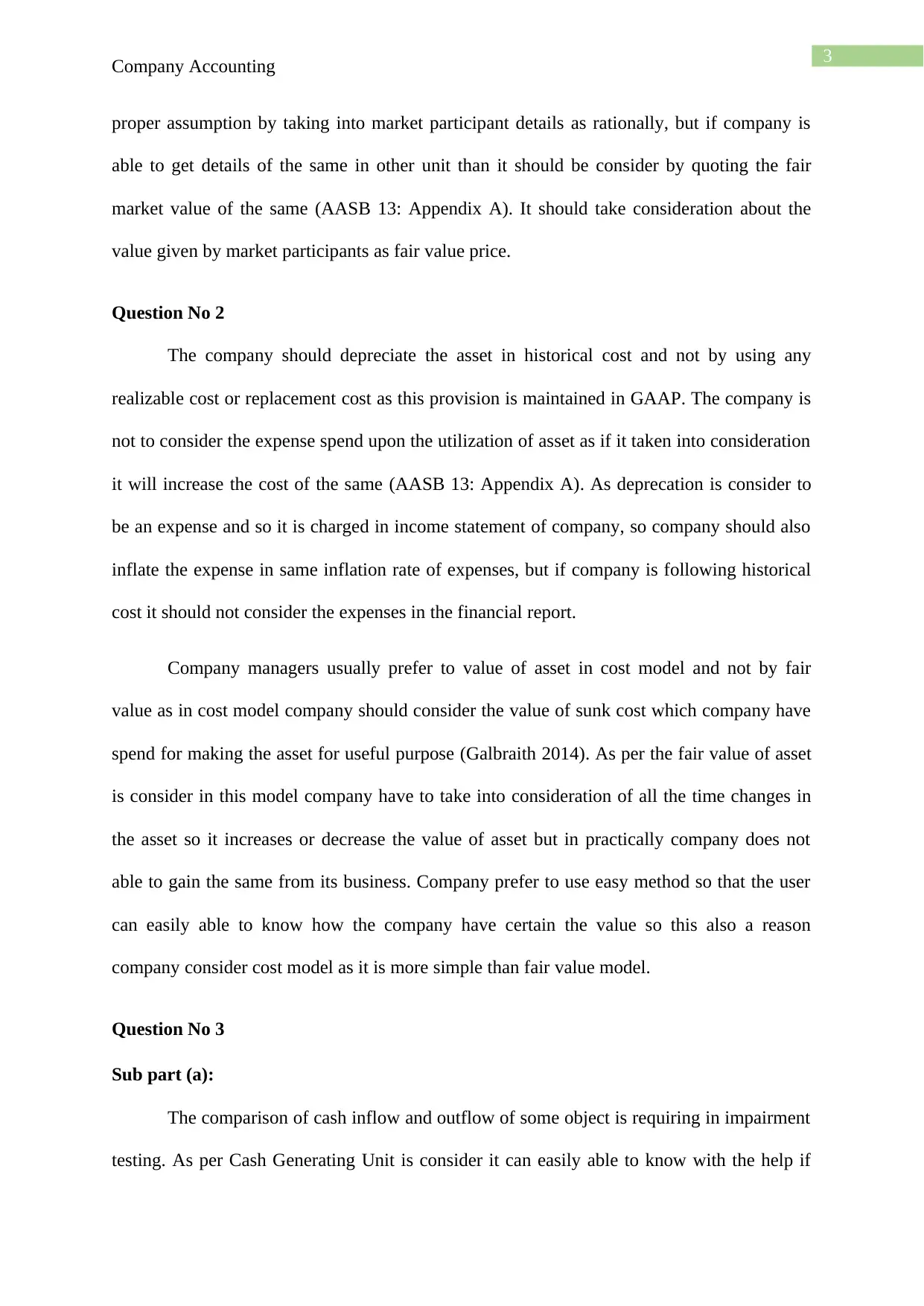
3
Company Accounting
proper assumption by taking into market participant details as rationally, but if company is
able to get details of the same in other unit than it should be consider by quoting the fair
market value of the same (AASB 13: Appendix A). It should take consideration about the
value given by market participants as fair value price.
Question No 2
The company should depreciate the asset in historical cost and not by using any
realizable cost or replacement cost as this provision is maintained in GAAP. The company is
not to consider the expense spend upon the utilization of asset as if it taken into consideration
it will increase the cost of the same (AASB 13: Appendix A). As deprecation is consider to
be an expense and so it is charged in income statement of company, so company should also
inflate the expense in same inflation rate of expenses, but if company is following historical
cost it should not consider the expenses in the financial report.
Company managers usually prefer to value of asset in cost model and not by fair
value as in cost model company should consider the value of sunk cost which company have
spend for making the asset for useful purpose (Galbraith 2014). As per the fair value of asset
is consider in this model company have to take into consideration of all the time changes in
the asset so it increases or decrease the value of asset but in practically company does not
able to gain the same from its business. Company prefer to use easy method so that the user
can easily able to know how the company have certain the value so this also a reason
company consider cost model as it is more simple than fair value model.
Question No 3
Sub part (a):
The comparison of cash inflow and outflow of some object is requiring in impairment
testing. As per Cash Generating Unit is consider it can easily able to know with the help if
Company Accounting
proper assumption by taking into market participant details as rationally, but if company is
able to get details of the same in other unit than it should be consider by quoting the fair
market value of the same (AASB 13: Appendix A). It should take consideration about the
value given by market participants as fair value price.
Question No 2
The company should depreciate the asset in historical cost and not by using any
realizable cost or replacement cost as this provision is maintained in GAAP. The company is
not to consider the expense spend upon the utilization of asset as if it taken into consideration
it will increase the cost of the same (AASB 13: Appendix A). As deprecation is consider to
be an expense and so it is charged in income statement of company, so company should also
inflate the expense in same inflation rate of expenses, but if company is following historical
cost it should not consider the expenses in the financial report.
Company managers usually prefer to value of asset in cost model and not by fair
value as in cost model company should consider the value of sunk cost which company have
spend for making the asset for useful purpose (Galbraith 2014). As per the fair value of asset
is consider in this model company have to take into consideration of all the time changes in
the asset so it increases or decrease the value of asset but in practically company does not
able to gain the same from its business. Company prefer to use easy method so that the user
can easily able to know how the company have certain the value so this also a reason
company consider cost model as it is more simple than fair value model.
Question No 3
Sub part (a):
The comparison of cash inflow and outflow of some object is requiring in impairment
testing. As per Cash Generating Unit is consider it can easily able to know with the help if
Paraphrase This Document
Need a fresh take? Get an instant paraphrase of this document with our AI Paraphraser
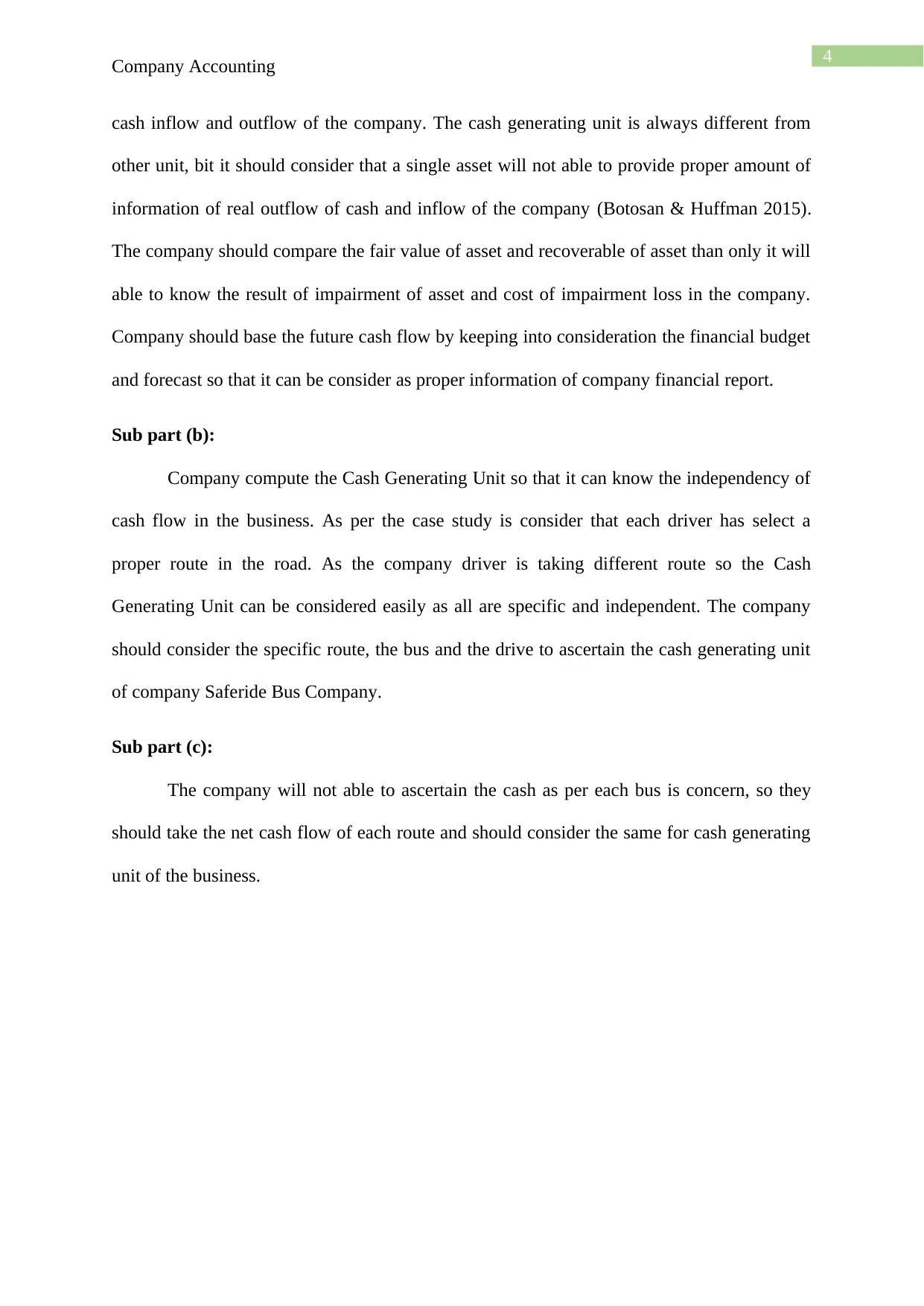
4
Company Accounting
cash inflow and outflow of the company. The cash generating unit is always different from
other unit, bit it should consider that a single asset will not able to provide proper amount of
information of real outflow of cash and inflow of the company (Botosan & Huffman 2015).
The company should compare the fair value of asset and recoverable of asset than only it will
able to know the result of impairment of asset and cost of impairment loss in the company.
Company should base the future cash flow by keeping into consideration the financial budget
and forecast so that it can be consider as proper information of company financial report.
Sub part (b):
Company compute the Cash Generating Unit so that it can know the independency of
cash flow in the business. As per the case study is consider that each driver has select a
proper route in the road. As the company driver is taking different route so the Cash
Generating Unit can be considered easily as all are specific and independent. The company
should consider the specific route, the bus and the drive to ascertain the cash generating unit
of company Saferide Bus Company.
Sub part (c):
The company will not able to ascertain the cash as per each bus is concern, so they
should take the net cash flow of each route and should consider the same for cash generating
unit of the business.
Company Accounting
cash inflow and outflow of the company. The cash generating unit is always different from
other unit, bit it should consider that a single asset will not able to provide proper amount of
information of real outflow of cash and inflow of the company (Botosan & Huffman 2015).
The company should compare the fair value of asset and recoverable of asset than only it will
able to know the result of impairment of asset and cost of impairment loss in the company.
Company should base the future cash flow by keeping into consideration the financial budget
and forecast so that it can be consider as proper information of company financial report.
Sub part (b):
Company compute the Cash Generating Unit so that it can know the independency of
cash flow in the business. As per the case study is consider that each driver has select a
proper route in the road. As the company driver is taking different route so the Cash
Generating Unit can be considered easily as all are specific and independent. The company
should consider the specific route, the bus and the drive to ascertain the cash generating unit
of company Saferide Bus Company.
Sub part (c):
The company will not able to ascertain the cash as per each bus is concern, so they
should take the net cash flow of each route and should consider the same for cash generating
unit of the business.
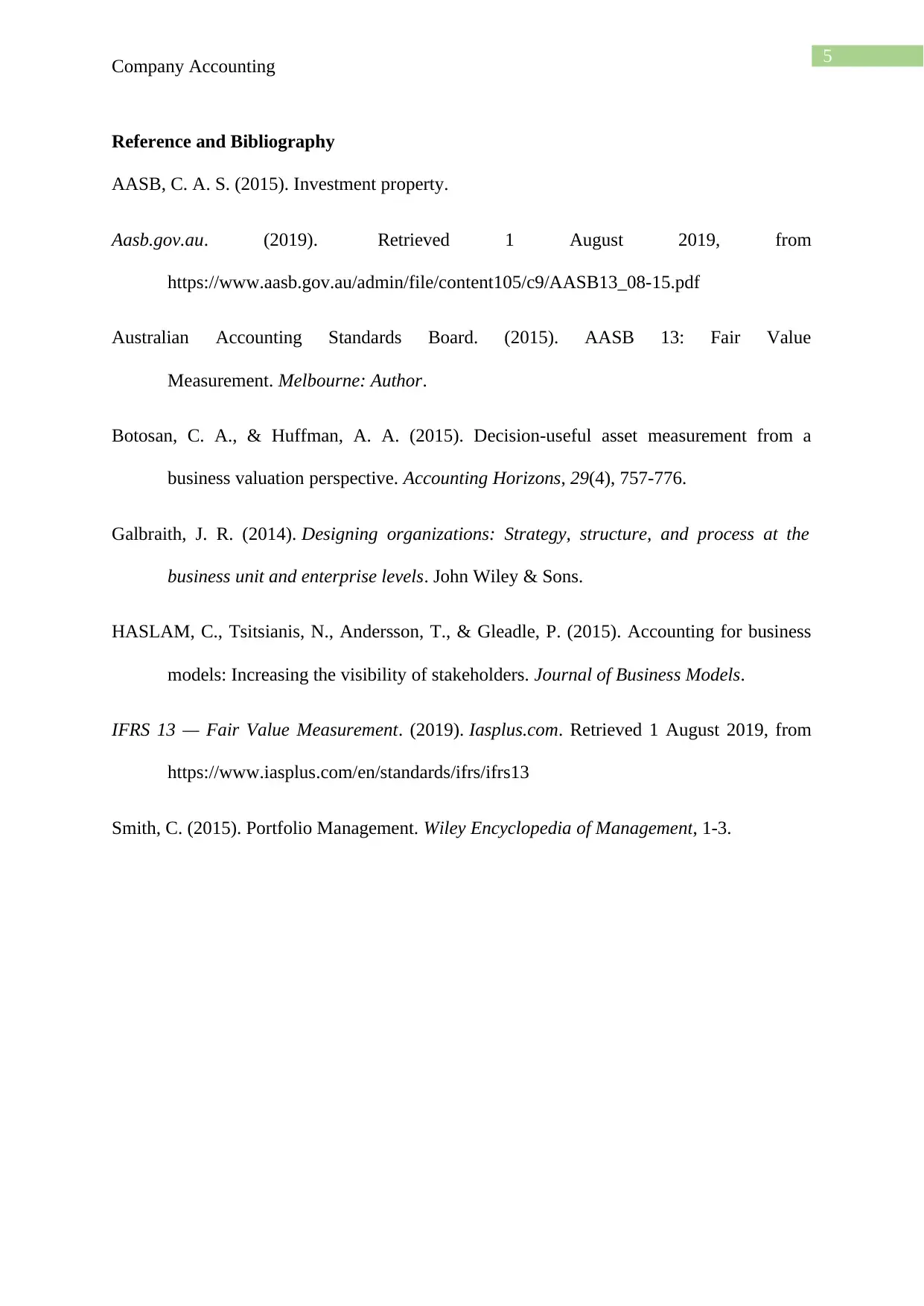
5
Company Accounting
Reference and Bibliography
AASB, C. A. S. (2015). Investment property.
Aasb.gov.au. (2019). Retrieved 1 August 2019, from
https://www.aasb.gov.au/admin/file/content105/c9/AASB13_08-15.pdf
Australian Accounting Standards Board. (2015). AASB 13: Fair Value
Measurement. Melbourne: Author.
Botosan, C. A., & Huffman, A. A. (2015). Decision-useful asset measurement from a
business valuation perspective. Accounting Horizons, 29(4), 757-776.
Galbraith, J. R. (2014). Designing organizations: Strategy, structure, and process at the
business unit and enterprise levels. John Wiley & Sons.
HASLAM, C., Tsitsianis, N., Andersson, T., & Gleadle, P. (2015). Accounting for business
models: Increasing the visibility of stakeholders. Journal of Business Models.
IFRS 13 — Fair Value Measurement. (2019). Iasplus.com. Retrieved 1 August 2019, from
https://www.iasplus.com/en/standards/ifrs/ifrs13
Smith, C. (2015). Portfolio Management. Wiley Encyclopedia of Management, 1-3.
Company Accounting
Reference and Bibliography
AASB, C. A. S. (2015). Investment property.
Aasb.gov.au. (2019). Retrieved 1 August 2019, from
https://www.aasb.gov.au/admin/file/content105/c9/AASB13_08-15.pdf
Australian Accounting Standards Board. (2015). AASB 13: Fair Value
Measurement. Melbourne: Author.
Botosan, C. A., & Huffman, A. A. (2015). Decision-useful asset measurement from a
business valuation perspective. Accounting Horizons, 29(4), 757-776.
Galbraith, J. R. (2014). Designing organizations: Strategy, structure, and process at the
business unit and enterprise levels. John Wiley & Sons.
HASLAM, C., Tsitsianis, N., Andersson, T., & Gleadle, P. (2015). Accounting for business
models: Increasing the visibility of stakeholders. Journal of Business Models.
IFRS 13 — Fair Value Measurement. (2019). Iasplus.com. Retrieved 1 August 2019, from
https://www.iasplus.com/en/standards/ifrs/ifrs13
Smith, C. (2015). Portfolio Management. Wiley Encyclopedia of Management, 1-3.
⊘ This is a preview!⊘
Do you want full access?
Subscribe today to unlock all pages.

Trusted by 1+ million students worldwide
1 out of 6
Related Documents
Your All-in-One AI-Powered Toolkit for Academic Success.
+13062052269
info@desklib.com
Available 24*7 on WhatsApp / Email
![[object Object]](/_next/static/media/star-bottom.7253800d.svg)
Unlock your academic potential
Copyright © 2020–2025 A2Z Services. All Rights Reserved. Developed and managed by ZUCOL.





